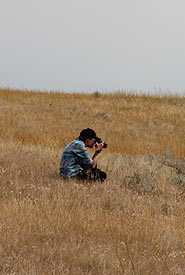Why take the time?
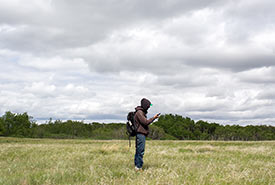
Bioblitz in action at Dundurn, NCC's newest property in Saskatchewan (Photo by Meghan Mickelson)
A first-timer’s experience with volunteering for the Nature Conservancy of Canada (NCC):
It was a Saturday morning in June — cloudy and windy, as most prairie days are. My partner and I loaded up our gear and head off to pick up a friend, Larry, who was sharing a ride with us out to Dundurn, Saskatchewan. Once in Dundurn, we met up with some NCC staff, as well as other Conservation Volunteers, and carpooled into NCC’s newest property in Saskatchewan for its first bioblitz.
We offered to drive in and took two other volunteers with us. After introductions in the car, we quickly realized that this was the first time any of us had been on a bioblitz, and the first time we had volunteered for NCC. Even though we had all heard about the event in different ways, and came from different places (Saskatoon and Regina), we all ended up here together. We were five people taking the time — their first time — to volunteer for nature.
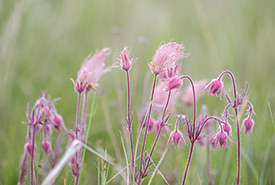
Three-flowered avens (Photo by Meghan Mickelson)
We pulled up to the property and met some more NCC staff, one of whom adorned us each with a green NCC buff as a token of appreciation. An NCC staff opened the fence and we began exploring. We formed small groups and looked for plants, animals, fungi and more for the next four hours.
My group — Larry, my partner and myself — followed a trail, taking photos of everything we saw. After the event, we shared these images with NCC through a website and phone app called iNaturalist, to help document the species on the property. There is magic in discovering a new area: you never know what is around each bend or behind each grove of trees. On the lookout for rare species, we saw many common plants, some unknown ones and lots of moose droppings.
At lunch time, we tried to escape the wind by nestling into a depression in a sand dune, known as a dune blowout. Sitting down in one place for a long time is a great way to get a different perspective of the plants and animals in the area. It was while we were chowing down and chatting that we saw a plant that we hadn’t seen anywhere else so far that day. Because of the way the plant was nestled in with other plants, we only saw it by sitting down and taking the time to gaze. This was an exciting find for us.
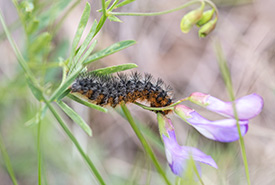
Salt marsh moth caterpillar (Photo by Meghan Mickelson)
Time flew by, and the day was over before we knew it. After a group photo, we checked ourselves for ticks and climbed back into the car. The five newbies were happy to be out of the wind, and as we got (briefly) lost on the way back to the meeting point, we talked about the day and our experiences. Having been uncertain about what it would be like at the start, we all agreed that this would not be our last event!
I cannot wait to return to the property at Dundurn to watch the flowers bloom and the landscape change with the seasons.
Why I take the time
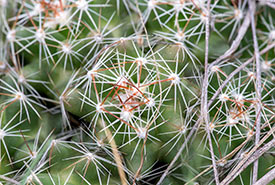
Ball cactus (Photo by Meghan Mickelson)
Growing up in Saskatchewan, I never really appreciated the landscape for what it was. As a child, I thought that the prairies were flat and boring. I moved away to Vancouver Island in my 20s for almost 10 years, and returned in 2013. Since then, I have discovered the opposite of what I thought was true — the prairies are diverse in landscapes, plants, bugs and animals.
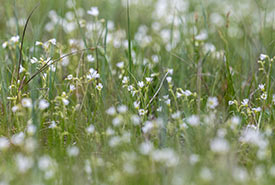
Field mouse-ear chickweed (Photo by Meghan Mickelson)
My lifelong passion for photography began to merge with my passion for the prairies, which has led me to volunteering for conservation organizations. I love exploring, taking photos of flowers, bugs and the land. By sharing my photos, I hope to raise awareness of the small things that are out there in a seemingly “flat and boring” field of grass.
Why you should take the time
Conservation matters, and taking the time to help organizations that are working to conserve our beautiful world is important. Events like bioblitzes are an opportunity to meet other people interested in the natural world, learn their stories and share your own. If you have the time — or if you can make the time — I encourage you to attend a Conservation Volunteers event near you. I promise that you won’t be disappointed.

